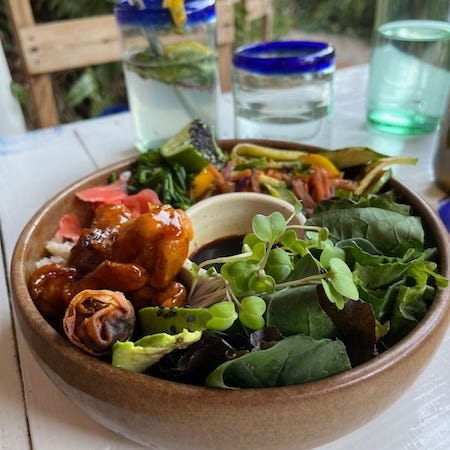Welcome to Roots! A newsletter about plant-based: eating, nutrition, lifestyle, I cover it all. Join me, Lori Osterberg, as I explore good food, great health, and Gorgeous Wellth! New here? Get started.
Sitting on the plane, I started my to-do list for when I got home. Of course, there’s the typical laundry list (literally, laundry), catching up on emails, and deleting the large stack of mail that will inevitably be on the table. But I turn to other thoughts too, like how I’m going to dive back into good eating.
Yes, I’m still very conscious about what I eat while away from home. I cook meals from my Airbnb location to keep my body well-adjusted. But you can’t avoid the really great restaurants with foods you would never eat at home. It happens.
In the heart of Ajijic, a gorgeous little town we stayed in for fifteen days, was a backyard restaurant called Vegan Town. It was an oasis in the middle of central, set behind the walls as you walked down the street. Pass through the gate and you are in the middle of a garden, a handful of tables ready and waiting.
The food was excellent. Vegan, of course. So we visited twice. Mmm …
As I was flying home, their Buddah bowl came to mind. I’ve had Buddha bowls many times - I make them regularly. Of course, everyone has their take on what a Buddha bowl is, and I LOVED what Vegan Town included in theirs. I wanted to replicate it at home. Of course, that means adding my own flare to it.
As I browsed my local grocery store and bought what I needed, I thought it would be fun to write about some of the processes I use when replicating menu items. It’s easier than you think, and the outcomes can be Gorgeous!
Step One
The best place to start is by falling in love … with a meal, of course! At the end of the meal, you know you’ve found one you could happily eat again and again. And again!
But you don’t live anywhere near those meals. So the only way to bring them home with you is by replicating them. Luckily, it’s not a difficult process.
Your starting point is to photograph those meals. I know, so many of us are tired of taking photos of everything. But in this case, it’s the best way to remember everything you can about it. Photographs help you recall textures, tastes, whether a food is salty or citrusy. You see it in action … before you gobble it down.
I also take a photo of the menu - or head online and view how they describe it on their menu. This might clue you in on things you miss. Hidden ingredients - perhaps fresh ginger or freshly cut chives. This can give you clues on how to search and build.
Step Two
Some meals are one unit - lasagna. Others, like my Buddha bowl - are several items combined. But even if you have something like lasagna, you can start pulling apart things that made it special - sauteed mushrooms in a umami sauce, or a pesto sauce instead of classic marinara.
For my Buddha bowl, two things stood out to me: pickled veggies and a tempura cauliflower. The teriyaki sauce also had a rich, earthy flavor.
With these ideas in mind, I spent time online searching for recipes that matched my ideas and seemed like they would be a good fit for my replicated Buddha bowl.
Step Three
The biggest tip I have for you is to focus on flavor. Of course, this starts when you’re eating the meal. That’s partially why I went back to Vegan Town twice. The second time was about paying attention.
Yes, a lot of this comes with cooking. The more you cook, the more you’ll understand how flavors come together. But it helps you when you’re looking for recipes online. Does it have an umami-rich flavor? Nutritional yeast, mushrooms, miso, and tamari can all do wonders for the meal. Herbs and spices are also easy to identify when you use them enough and know how they feel in your mouth.
I know my first attempt won’t get everything right. And that’s okay. But I’ll learn. And I’ll have a better idea of what to try the next time.
This is also how my recipe will morph and change. I’ll like something a little more than other things I try. I’ll come up with something to add, or something to take away. Because ultimately, it’s all about creating something you love to eat and will continue to add to your recipe collection at home.
Step Four
I’ll also mention that you can focus on recreating your meat-based meals and turning them into plant-based meals if you’re trying to move away from meat.
Let’s take the traditional burger. For many, people like the mouthfeel of a traditional burger. Some of the newer plant-based burgers are designed to give you that mouthfeel. But they are anything but plant-based, and definitely not healthy.
That’s when you can come up with healthier versions that are actually healthy. Meat can be substituted with mushrooms, jackfruit, tofu, tempeh, beans, or legumes. Dairy can use plant-based milks, cashew cream, and coconut yogurt. Eggs can be recreated with silken tofu, flax eggs, or commercial egg replacers. Fish can be replaced with hearts of palm, artichokes, and kelp.
Many vegetarian, vegan, and plant-based cookbook authors strive to replace common, well-known meals with plant-based alternatives. A quick search will help you find many recipes that do it well.
And I think that’s a great place to start. As your cooking skills improve and you get more creative with your meal-planning process, that’s when you’ll discover how to use these products in new and inventive ways.
Step Five
The first night home, I recreated the Buddha bowl I had in Ajijic. And it was … okay. Not spectacular, just good. We all gobbled it up in record time.
Then, we critiqued it. The teriyaki sauce I made was way too salty. The baked tempura cauliflower I cooked didn’t pack the punch I was looking for. And the pickled veggies I made needed more time pickling. (And more flavor.)
Once again, I took notes. And I’m already looking forward to trying it once again.
This is where you make it your own.
In Ajijic, the bowl came on a bed of brown rice. I substituted farro because I love the nutty flavor and wanted more protein and fiber. I like ginger, but several slices of it in a bowl is too much. I added it to my teriyaki sauce instead of slices in the bowl. And I added some cucumber and other fresh veggies I like instead.
I threw in some nuts and seeds because I wanted the added nutrients. Nutritional yeast added to the sauce gave it increased flavor. And while tempura cauliflower was mmm, oh so good, I wanted something healthier in my own bowl. A baked tempura with lots of spices did the trick.
Of course, I’ll be adding more to my meal the next time I make it. And I’m looking forward to it. Because no matter how I make it, I know it will be delicious and nutritious. And always remind me of the magical time I spent in Ajijic.
That’s a win/win, right?
Stay tuned. I’ll bring you the recipe for my version soon.
p.s. Did you like this message? It would mean a lot to me if you’d press the ❤️ below if you liked it, left a comment 💬, or shared it with a friend. I’m trying to grow this publication, and I depend on people like you to do so!
And if you’re new here, Welcome! 💐 I’d love to start sharing my message with you if you’re interested in all things plant-powered, proaging, or finding kitchen joy. Subscribe … and then explore my entire archive! Glad to share with you! 🙋🏼♀️










Thanks for posting this! A very enlightening dive into the thought processes ☺️.